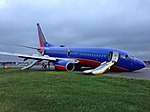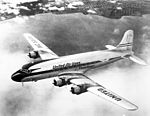USAir Flight 5050
1980s in Queens1989 in New York CityAccidents and incidents involving the Boeing 737 ClassicAirliner accidents and incidents caused by pilot errorAirliner accidents and incidents in New York City ... and 6 more
Airliner accidents and incidents involving runway overrunsAviation accidents and incidents in the United States in 1989LaGuardia AirportSeptember 1989 events in the United StatesUS Airways accidents and incidentsUse mdy dates from September 2016

USAir Flight 5050 was a passenger flight that crashed on takeoff from LaGuardia Airport in Queens, New York. As the plane took off from LaGuardia's runway 31, the plane drifted to the left. After hearing a loud bang, the pilots attempted to abort the takeoff, but were unable to stop the plane short of the end of the runway. The plane continued past the end of the runway and plunged into Bowery Bay. Two passengers were killed.
Excerpt from the Wikipedia article USAir Flight 5050 (License: CC BY-SA 3.0, Authors, Images).USAir Flight 5050
Bowery Bay Boulevard, New York Queens
Geographical coordinates (GPS) Address Nearby Places Show on map
Geographical coordinates (GPS)
| Latitude | Longitude |
|---|---|
| N 40.776 ° | E -73.885 ° |
Address
P10 Terminal B Wait Area and Employee Parking
Bowery Bay Boulevard
11371 New York, Queens
New York, United States
Open on Google Maps









